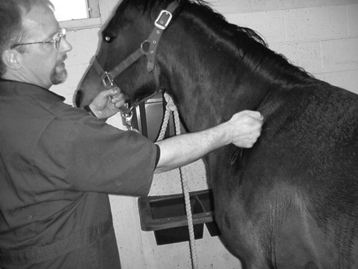CHAPTER 46. Restraint
Rebecca S. McConnico
GENERAL CONSIDERATIONS
I. Most important aspect of the equine physical examination
II. Improper restraint will result in a poor examination
III. Horse may:
A. Kick
B. Bite
C. Rear
D. Strike
IV. Safety is the most important aspect
A. Veterinarian: No job is worth doing if you get hurt
B. Handler (owner, manager, or assistant): The veterinarian must trust the handler’s restraint capability. Be aware of legal considerations if the handler or the animal is injured as a result of restraint techniques
C. It is safest to use the most minimal restraint possible
D. Restraint does not need to equate to physical force
E. What typically works for one horse will not necessarily work for another. Draft horses, although larger, may need little restraint compared with a young 2-year-old thoroughbred horse
F. Approach the horse from the left side
G. Safest place to work is by the shoulder area
H. Handler and examiner should be on the same side of the horse
CATEGORIES OF RESTRAINT (CAN BE USED ALONE OR TOGETHER)
I. Physical
A. Minimum restraint required: Halter and lead rope
1. Never attempt to do a physical examination without a halter and lead rope in place and someone holding the horse
2. Do not wrap a lead around your hand, arm, or any other body part
3. Do not tie a horse unless you know it is accustomed to being tied
B. Chain over the nose or under the upper lip may provide additional restraint. This method is often used on young horses or stallions
C. Twitching
1. Twitching with hand (grasp skin with hand and pull/twist with a firm grip) (Figure 46-1)
 |
| Figure 46-1 Grasp as much skin on the horse’s shoulder as possible with one or both hands. (From Sheldon CC, Topel J, Sonsthagen TF. Animal Restraint for Veterinary Professionals. St Louis, 2006, Mosby.) |
2. Neck or shoulder twitch
3. Nose twitch: Use a chain or nylon rope twitch, pull upper lip through a loop of chain or rope, and twist firmly
4. Ear twitch: Grasp ear with hand and twist firmly
D. Twitching devices
Stay updated, free articles. Join our Telegram channel

Full access? Get Clinical Tree


